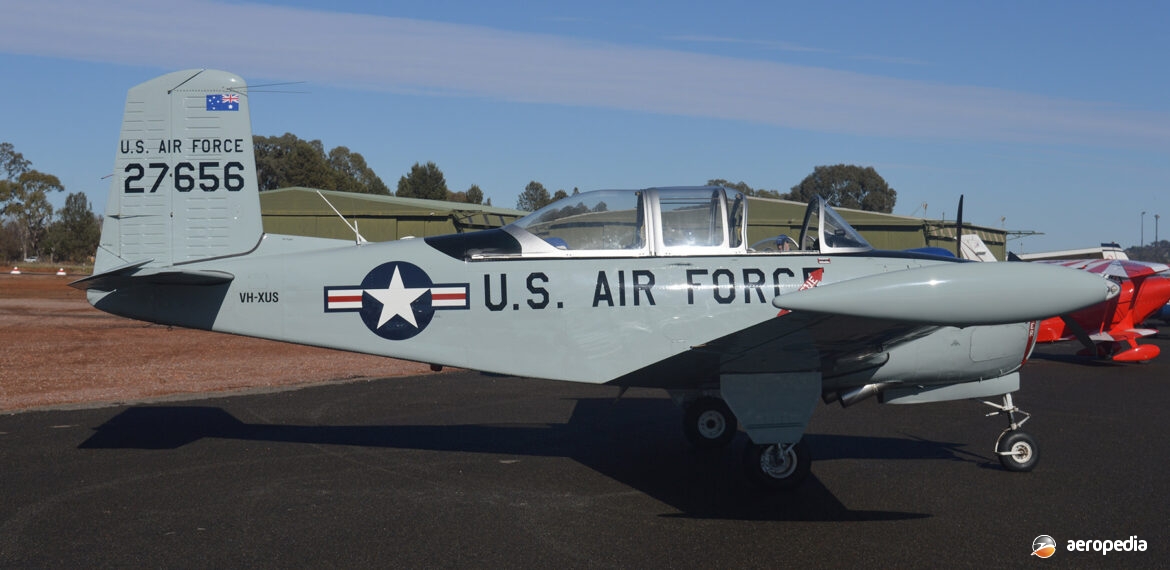Photograph:
Beech T-34 Mentor VH-XUS (c/n G-37) at Parkes, NSW in September 2019 (PJ Ricketts)
Country of origin:
United States of America
Description:
Two-seat primary military trainer
Power Plant:
One 168 kw (225 hp) Continental O-470-13 six-cylinder horizontally-opposed air-cooled engine
Specifications:
- Wingspan: 10 m (32 ft 9¾ in)
- Length: 7.96 m (25 ft 11¼ in)
- Height: 2.92 m (9 ft 7 in)
- Wing area: 16.49 m² (177.6 sq ft)
- Max speed at sea level: 302 km/h (188 mph)
- Cruising speed: 269 km/h (167 mph)
- Initial rate of climb: 375 m/min (1,230 ft/min)
- Max cruising range: 1,186 km (737 miles)
- Empty weight: 978 kg (2,156 lb)
- Loaded weight: 1,338 kg (1,950 lb)
History:
The Beechcraft Mentor was basically a re-design of the well-known Beech Bonanza series of aircraft aimed at the military trainer market. With a re-designed fuselage to accommodate the pupil and instructor in tandem, orthodox tail surfaces were incorporated, as were other modifications to meet US military requirements.
Two prototypes were built, and the first of these made its initial flight on 2 December 1948. In 1950 three examples, known as the T-34, were evaluated by the USAF, orders subsequently being placed for 150 examples from Beech Aircraft Corporation and 100 from the Canadian Car & Foundry, known as the T-34A. The type proved very successful in its role and examples were supplied to the air forces of Canada, Chile, Colombia, and El Salvador. The Mentor also saw service with the US Navy as the T-34B.
The T-34B was also licence-built in Japan for the Japanese Air Self Defence Force by Fuji Heavy Industries, and this company exported a number to The Philippines and Argentina, the latter country receiving 15 complete aircraft and assembling 75 from components in Cordoba. In addition, Fuji Heavy Industries built a four-seat general-purpose and liaison model of the Mentor known as the LM-1 Nikko, this aircraft basically having a re-designed fuselage. The first of this model flew on 6 June 1955. This model had the 168 kw (225 hp) Continental O-470-13A engine, but a subsequent model, known as the Super-Nikko, later appeared with the 254 kw (340 hp) Lycoming GSO-480-B1-A6 engine.
In later years the type re-entered production in the USA as the Beech T-34C, fitted with a 298 kw (400 eshp) Pratt & Whitney PT6A-25 turboprop, and delivery of 334 examples to the US Navy was completed. An export version known as the Turbine Mentor T-34C was sold to the Algerian National School of Training; and examples of the T-34C-1 armament systems trainer were sold to Argentina, Ecuador, Gabon, Indonesia, Morocco, Peru and Uruguay.
Late in 1983 a T-34B arrived in Melbourne, VIC for restoration. This aircraft was built by Fuji for the Philippine Air Force. Some parts such as the cockpit canopy, seats, etc were missing when it arrived. However, the aircraft was not restored, and remained in storage in Victoria until it was exported.
In late 2000 a T-34A (serial FM111) built in 1959, also an ex-Philippine Air Force machine (some reports indicate ex-Thailand Air Force), was noted for sale at Bankstown, NSW. In 2001 it was exported to France.
In 2013 a further example, described as a Model A-45, was imported to Redcliff, QLD, where it became VH-XUS (c/n G-37 – ex N10441, 52-7656), being operated by Aerotrek Pty Ltd of Scarborough Qld, being registered on 30 October 2014.
In the 1970s a Beech Turbo Mentor was brought to Australia as part of a sales tour, this being aimed at interesting the RAAF in purchasing the type as an advanced trainer, but the aircraft was not obtained and, after some demonstration flights from Essendon, VIC, it returned to the United States.

